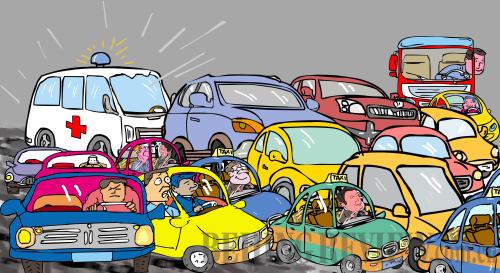|
 |
|
(LI SHIGONG) |
On December 7, a first-aid ambulance got caught up in Beijing traffic. It took the vehicle 40 minutes to travel 3 km. Due to the delay, the patient onboard died. The incident attracted wide-spread attention from all corners of society.
In November, a worker who had suffered a severe cut to his hand in Xiamen, southeast China's Fujian Province, missed the chance for a finger transplant when his ambulance got trapped on a major bridge for two hours.
According to many first-aid workers, at least 30 percent of patients transported via ambulance miss their appointments for medical treatment because of traffic jams and occupied emergency lanes.
With China's urban streets becoming increasingly crowded, what can be done to ensure the effective operation of emergency services? What can traffic police do to avoid or punish violations? The following are excerpts of some opinions:
He He (gb.cri.cn): I am shocked by serious traffic jams. Ambulances are allowed to use emergency lanes and sirens when executing urgent tasks. Meanwhile, it is also stipulated in relevant regulations that drivers and pedestrians are obligated to make room for ambulances. However, many vehicles choose to turn a blind eye to such rules. The fundamental reason for this mess is the lack of punishment aimed at those occupying emergency lanes in heavy traffic.
In 2009, a serious traffic accident in Beijing claimed seven lives and injured one person. This led to several hours of traffic congestion. The most tragic scene was, while injured passengers lay strewn around waiting for help, emergency lanes remained blocked. As a result, ambulances were only able to access the scene after a delay of 20 minutes, when the crucial moment for aid had already been missed.
Those who refuse to make way for ambulances and occupy emergency lanes must receive similar punishments to that of drunk drivers. Of course, ambulances should avoid abusing sirens and warning lights. They are allowed to use these tools only in emergencies.
Mu Yifei (www.rednet.cn): Surveys show that over half of private car owners say they will not make way for emergency vehicles. Some drivers confess they have never met with such cases and would not know what to do. A few even think they might be violating traffic rules by making way for ambulances and face punishment.
Indeed, current traffic regulations only highlight the privileged right of emergency vehicles and that other cars and pedestrians have an obligation to make way, but there is little information regarding the consequences of breaking the law while complying with such measures.
In order for police cars, first-aid ambulances and fire engines to run smoothly, current traffic regulations must be updated. Some also argue that emergency vehicles are often used outside of their designated purposes and that efforts should be made to avoid their unofficial use.
| 